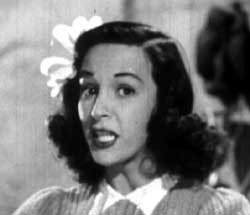 Backed by the unseen Hal Borne Orchestra, Diana del Rio gives a lively but not all that melodic rendition of a miserable little novelty song in the three-minute soundie There's a Pampus Moon on the Campus (1942). The lyrics run in part:
Backed by the unseen Hal Borne Orchestra, Diana del Rio gives a lively but not all that melodic rendition of a miserable little novelty song in the three-minute soundie There's a Pampus Moon on the Campus (1942). The lyrics run in part:
"Have you heard? Have you heard?/ Our university has just been hit/ By that epidepic that keeps you fit/ Take my word! Take my word!/ Just watch the alumni turn out en masse/ To learn the rhythm that gives them class/ There's a pampus moon on the campus/ Cuz the rhumba is the dance they all adore...."
Diana leaps up from between the two guys she was singing to & dances around a student lounge, vamping at tables. Then all the students leap up to rhumba as Diana sings & tramps around to a vaguely latin beat.
Thanks to some amusing choreography it's visually quite a winning soundie, in many ways a quintessential example of the film type.
It was included in a one-reel anthology film with two other soundies as College & Carnival Rhythm (1945). The other two soundies on this reel are by the absolutely awful "Collegians" aka Men & Maids of Rhythm, On the Campus (1941) & Ding-a-Lay-o (1941).
For On the Campus the viewer has to suffer through some college tunes with football footage very similar to the Collegians' equally horrible On to Victory (1941), with some vague dorm-room shinanigans implied to be a fraternity raiding a sorority.
As in other soundies featuring what is essentially a Panoram film studio band, the unseen orchestra is Ray Bloch's.
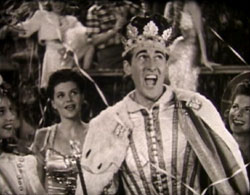 For Ding-a-Lay-O the Collegians/Men & Maids are again renamed, this time called the Carnival Chorus, the only time they were so-named.
For Ding-a-Lay-O the Collegians/Men & Maids are again renamed, this time called the Carnival Chorus, the only time they were so-named.
The novelty song is supposed to be popular at Mardis Gras, & the well-lit film stage is supposed to be a street in New Orleans by night.
Some who don't know there really is a Panama Way in New Orleans may have wondered why the lyrics set the scene in Panama.
Ray Bloch & His Orchestra again back the Minoco house chorus, with everyone dressed up in silly costumes, streamers dropping on them.
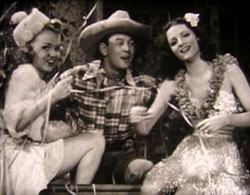 Unlike the Men & Maids, the Ray Bloch orchestra did have its separate existence as a touring & recording band, but as a soundies house band were prolific. Unlike the Men & Maids, the Ray Bloch orchestra did have its separate existence as a touring & recording band, but as a soundies house band were prolific.
They're heard in dozens of soundies for which the orchestra pre-recorded the music then weren't around for the filming. Ray generally arranged the tunes, but it was hasty work, all of it in 1941.
The dreadful song begins with a male lead: "It's mardi gras night/ It's time for fun night/ Join the masquerade/ Join the dance parade/ Down old Panama Way..."
Later there's a female vocalist with sombrero hanging on her back. She joins the male vocalist in his king outfit so they can sing together.
There's a chap with a mandolin & lots of dancing guys & gals who make it lively and visually appealing even if the song's basically annoying with the doubly annoying hook-phrase "Ding-a-lay-o, dinky dinky donk dont/ Ding-a-lay-o, dinky dinky donk donk.".
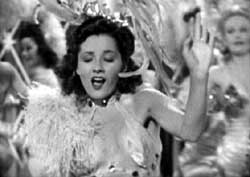 Wearing a ridiculous one-piece bathing suit with feathers added, & a matching feathered hat, Carol Adams stands on a hastily & excessively decorated stage singing Doin' the Hot Foot (1942). Wearing a ridiculous one-piece bathing suit with feathers added, & a matching feathered hat, Carol Adams stands on a hastily & excessively decorated stage singing Doin' the Hot Foot (1942).
"It happened when some practical joker put me upon the spot/ With the flamin' shoe I started to do the hot foot/ I never even knew I could dance but what a suprise I got/ For before I knew it I was doin' the hot foot.
"So I got over being just a wallflower then & there/ For in that heat my feat did things that even made Fred Astair tarry there/ And now I make ten thousand a week; I've limousines & a yauht/ And it's all on account of I invented the hot foot."
At the instrumental break a choras line dances in & Carol leads the gals in a mediocre dance routine the real jpurpose of which is to show lots of leg.
Soon after, out comes male dancer Billy Trueheart in a gaucho outfit. While he watches the other girls, Carol bends down & lights a match under his shoe. This starts him off on a comedy tapdance, with both shoes blazing, a startling stunt actually, as the flames are just shooting upward.
When Carol takes up the lyrics anew, Billy keeps dancing about, setting his gloves & hat on fire while he's at it, until the choras girls get a fire hose. It's a lively soundie to be sure, loads of fun, though the novelty number isn't as catchy as it needed to be.
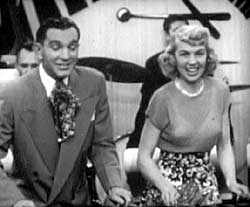 Paul & Jini Kohler oddly billed themselves as "Paul Kohler & Jini Herself." They were a Cleveland couple who played xylophone side-by-side, as can be witnessed in Kerry Dance & Irish Washing Woman (1951). Paul also had a separate career as a big-band xylophonist.
Paul & Jini Kohler oddly billed themselves as "Paul Kohler & Jini Herself." They were a Cleveland couple who played xylophone side-by-side, as can be witnessed in Kerry Dance & Irish Washing Woman (1951). Paul also had a separate career as a big-band xylophonist.
In the present Snader telescription they are backed by a small unnamed orchestra as they pound away on their instrument, he with four mallets, she with two, initially performing "Irish Washing Woman."
They come off as the sort of entertainers who turn up at old folks homes & elementary schools. Their attempts to convey lots of character comes off clownish.
Jini at one point puts on boxing gloves then plays the xylophone as though that'd be real hard to do, but what captures the attention more is the transluscence of her blouse showing her cheap bra which must've been embarrassing when she saw this on a panoram.
So Paul puts on boxing gloves to prove he can do it too & they play "The Kerry Dance" together. It's dumb & a half, but it would've gone over well as a street act in Disneyland of the late '50s.
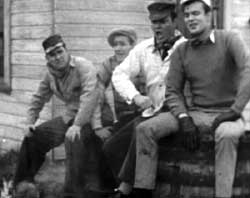 Who the heck are The Men of Song? Here they're a quartet dressed in laborer outfits in front of a run-down wooden shed singing the 19th Century American work song Drill Ye Tarriers Drill (1951):
Who the heck are The Men of Song? Here they're a quartet dressed in laborer outfits in front of a run-down wooden shed singing the 19th Century American work song Drill Ye Tarriers Drill (1951):
"Every mornin' at seven o'clock/ There were twenty tarriers a-workin' at the rock/ And the boss comes along & he says keep still/ And come down heavy on the cast iron drill/
Drill ye tarriers drill/ Drill ye tarriers drill/ For it's work all day for your sugar & tay/ Down beyond the railway..."
I was prepared not to like this Snader telescription, but it turnoued to have a folky authenticity, & I actually loved it.
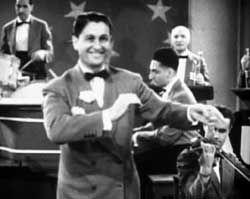 Before Lawrence Welk hit it big on television, he & his Champaign Orchestra were a hard-working band of no real national consequence. One of his early breaks was making it onto the panoram jukeboxes with a handful of soundies, including Home Again Polka (1944). Before Lawrence Welk hit it big on television, he & his Champaign Orchestra were a hard-working band of no real national consequence. One of his early breaks was making it onto the panoram jukeboxes with a handful of soundies, including Home Again Polka (1944).
The most interesting thing about this soundie is the reassurance, if we needed any, that Welk always sounded exactly like that, no matter who he invited to sing. Featured are the Champaign Lady, Jayne Walton, with Bobby Beers.
He decorates the set patriotically (it's 1944 after all). Bobby Beers begins singing: "When the great days roles around/ & the boys are homeward bound/ How their happy hearts will pound/ Just to know they're going back where they belong."
Almost certainly filmed for cut-ins long after Welk left the stage, we see couples dancing in front a set of American flags, the worst polka dancing you've seen since junior highschool.
The girls' skirts are mini-skirts before the mini-skirt era, something Welk would never have permitted if he'd been present. The next cut-in has seven of the eight dancers seated but one is twirling like a crazed ballerina showing her striped undies.
After the cheesecake moment we see Lawrence's champaign lady with a a perm, Jayne Walton, properly evening-gowned to continue the lyrics. The awfulness of this soundie makes it great.
copyright © by Paghat the Ratgirl
|
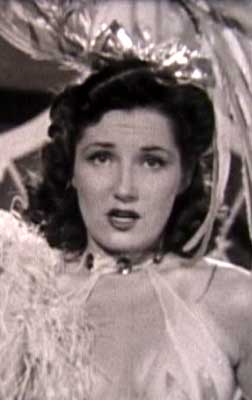


 Unlike the Men & Maids, the Ray Bloch orchestra did have its separate existence as a touring & recording band, but as a soundies house band were prolific.
Unlike the Men & Maids, the Ray Bloch orchestra did have its separate existence as a touring & recording band, but as a soundies house band were prolific.


